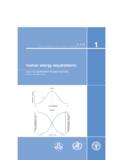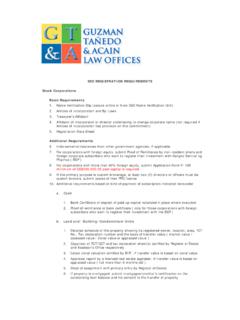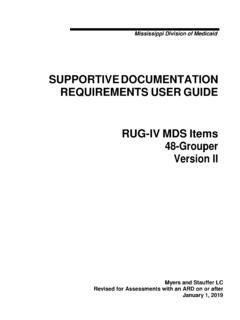Transcription of Detailed Project Report (DPR) :Model template
1 1 Detailed Project Report (DPR) :Model template for NHB Scheme for Aonla Development of Commercial Horticulture through Production and Post-Harvest Management Horticultural crops 1. Open field condition 2. Integrated Post Harvest Management Crop Tick mark Scheme components 1. field condition of NHB specified crops Within overall cost ceiling +Farm Mechanisation +Good Agri. Practices (GAP) +Plastic Mulching 2. PHM Integrated Pack House Pack house Pre-cooling unit Cold Room (Staging) Primary Processing Refer Van Retail outlet Submitted by ------------------ Applicant with full correspondence address Detailed Project Report (DPR) duly to be signed by the applicant (s) / authorised person ( in case of legal entity)
2 On each page with date along with Horticulture and Project Finance Expert wherever applicable 2 Index Project at a Glance 1 About the Applicant /Promoter and his/her entrepreneurship 2 Details of benefits availed by the Applicant / Promoter 3 About Project -Name, Rationale, Management and Description 1. Name of Project , Activity, Objectives and expected Outcomes 2. Rationale / Justification for the Project 3. Site/ Land details- RoR/ Ownership / Registration of lease/ Map etc. 4. Location of the Project - Identification 5. Current usage of land of proposed Project Area 6. Current infrastructure and assets possessed by the Applicant: 7.
3 Lay out plan of the Project 8. Conversion of Land Use (CLU) 9. Whether Project site is part of production belt / cluster / hub 10. Rationale for the location of the Project 11. Compliance of Project site for food safety 12. Components / Activities of the Project with justification 13. Operations planning 14. Month wise operational chart / Implementation schedule 15. Backward and Forward linkages. 16. Manpower (Skilled & Unskilled labour etc.) availability 17. Employment generation 18. Infrastructure & Connectivity 19. SWOT Analysis 20. Monitoring and evaluation 4 NHB Scheme under which the Project is proposed with rationale / justification.
4 5 Project details Agro-climatic suitability / feasibility 1. Origin, introduction and distribution of crop in the said location, India and in the world (briefly) 2. Agro-climatic / Horticultural zones and suitability of the crop (s) 3. Soil type and latest health-suitability for the crop 4. Water (irrigation) source, availability, Quality and suitability Market viability 1. Commercial and Nutritive importance / significance, composition and Uses 2. Target Market (s) 3. Statistics: India and State: Area, Production and Productivity in the District, State and India for the last 5 years 4. Clusters of the Project crop in the state.
5 5. Demand and Supply gap 6. Global producers- Country, Area, Production, Productivity and global market share in the last available 5 years. 7. International trade and potential (for export oriented projects) 8. Seasonality of crop / produce and its comparison with other available crop/ produce 9. Price variation of commodity in the State and nearby markets 3 10. Balance sheet of commodity in the State 11. Transportation 12. Value Addition scope 13. Central and State Government policy 14. Value chain in the commodity 15. Proposed Business strategy for Market viability Financial viability 1. Due diligence status 2. Project Cost 3.
6 Means of Finance 4. Investment in Horticulture 5. Key financial Indicators 6. Project Financing 1. Rate of Interest 2. Percentage of Term loan against total Project cost 3. Internal Rate of Return (IRR) 4. Cost of Production and Profitability 5. Yield and Sales Chart 6. Proposed Balance Sheet 7. Proposed Cash flow Statement for repayment period. 8. Proposed Profit & Loss Account 9. Proposed Repayment of Term loan and Schedule 10. Break Even Analysis 11. NPV (Net Present Value) 12. Economic Rate of Return 13. Depreciation 7. Risk Analysis and management 8. Statement of Assets and liabilities 9. Farm record keeping/ Maintenance proposed Land development and Crop Husbandry development of Quality Planting Material 1.
7 Recommended and popular Cultivars- varieties/hybrids, their specific characteristics, requirements and yields. 2. Cultivar/Hybrid/Variety selected and Criterion adopted for selection 3. Propagation methods. 4. Accredited / Good Nurseries in the area 5. Planting material-source, quality and suitability / Site planning, Lay out and management 1. Planning, establishment and layout systems 2. Land preparation 3. Planting Season / time and density and transplanting 4. Water and Nutrient management 5. Intercultural operations including Weed management 6. Plant canopy architecture management/ training and pruning 7. Use of Pollinators & pollinisers 8.
8 Use of Plant growth regulators 9. Flowering& fruiting 4 10. Integrated Pest and Disease Management and Food Safety measures 11. Physiological disorders- causes, preventive and management measures. 12. Special problems if any Structures and Mechanisation 1. Farm Mechanisation and Fruit / flower care management Post-Harvest Management 1. Post-Harvest infrastructure scenario in horticulture sector in the State and specially for the proposed crop / component 2. Product/ Process Flow chart 3. Lay out / Floor Plan of post-harvest operations 4. Post-harvest operations 1. Pre-cooling 2. Curing 3. Cleaning / Washing 4.
9 Sorting and Grading 5. Packing and labelling 6. Ripening 7. Transport 8. Storage- Low cost / cold storage/ CA 5. Post-harvest infrastructure Integrated Post-harvest Management 1. Integrated Pack house 2. Pack House 3. Pre-cooling unit 4. Cold Room (Staging) 5. Primary Processing 6. Refer van 7. Retail outlet 8. Labour/ Store room Marketing 1. Connectivity 2. Aggregation & Assembling: Marketing infrastructure 3. Market Institutions and agents 4. Demand and Supply trends and forecast both in local and National markets. 5. Traceability record 6. Proposed value chain / method of Marketing by the Applicant Value addition / Processing 6 Technology providers 1.
10 ICAR /CAU/ SAU/SHU / Research Stations and Experts names 2. Experts-whose services are availed 3. Agri/Horti-Business incubators 7 Food Safety -With /Without GAP certification 1. GAP Certification if any 2. Food safety measures 5 1. Pre-planting 2. Crop husbandry 3. Harvestings 4. Post-harvest 8 Innovation if any 9 Profitability of the Project (Horti-business): Critical observations of Applicant 10 Checklist 11 Declaration from Crop Expert and Project Finance Expert 12 Self-declaration by the Applicant Annexure: Proposed stages in NHB Scheme Implementation Checklist of documents to be submitted at Market Viability and Financial Viability stage and during JIT.






